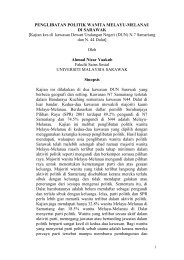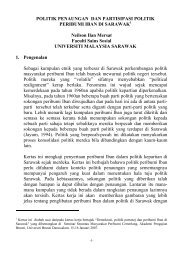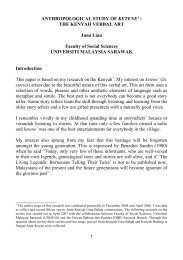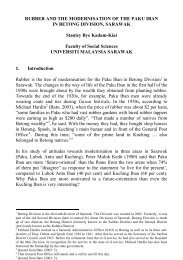OF SOUKHUAN AND LAOS Elena Gregoria Chai Chin Fern Faculty ...
OF SOUKHUAN AND LAOS Elena Gregoria Chai Chin Fern Faculty ...
OF SOUKHUAN AND LAOS Elena Gregoria Chai Chin Fern Faculty ...
Create successful ePaper yourself
Turn your PDF publications into a flip-book with our unique Google optimized e-Paper software.
should conduct herself in the presence of the senior members of her husband’s<br />
household, how she should not wake up later than her husband, how she should not go<br />
out when the sun is setting and many more. When all the khuan of the bride-to-be has<br />
come to the Phakhuan, the tying of the fai mon kon (the white cotton thread) began.<br />
Similar to other Soukhuan ceremony, the Mor Phon is the first person to tie the wrists<br />
of the bride-to-be and this is followed by the elders. Other relatives and friends will<br />
only have this done to them in Soukhuan Nyai (Big Soukhuan ceremony) to be held on<br />
the wedding day itself.<br />
After the Mor Phon has offered thanks to the thevada and invited them to return to the<br />
heavens, the Soukhuan Noi ceremony comes to an end officially. This is followed by a<br />
big buffet meal with unlimited flow of alcohol served in the house yard. Lao and Thai<br />
folk songs are sung and sometimes pop songs are performed by hired musicians. Men<br />
and women form a circle and dance the Lamvong, a Khmer traditional dance found in<br />
Laos and Cambodia.<br />
Lamvong is a slow revolving circle dance where men stand on the inside of the circle<br />
and the women on the outside. Dancers will move their hands slowly in expressive<br />
gestures. This will continue until midnight. Sometimes, relatives and friends become<br />
drunk and put up the night at the host’s house.<br />
Next morning, family members of the bride and groom are dressed in Sut Teng Dong<br />
or wedding suit. The bride could wear any colour whereas the groom should avoid<br />
wearing red colour or an entirely black suit since black represents solemnity. On a<br />
‘bright’ and auspicious day, any ‘solemn’ coloured attire is not permitted. Red<br />
symbolizes ‘blood’ and it is a taboo for the groom to wear such a ‘dangerous’ colour.<br />
A man dressed in red symbolizes a bleeding man in an accident or war. As for the<br />
bride, red Sut Teng Dong is permitted as bleeding in woman is associated with the<br />
monthly menstrual cycle which symbolizes fertility. When the Nyamdi (the auspicious<br />
time selected by the Mor Phon) approaches, the groom’s party set out to the bride’s<br />
house. Just before the party leaves, an elderly person lights a candle that will be<br />
carried by the groom to the bride’s house. Once lit, a crowd of elders or friends will<br />
escort the groom while drumming gongs and playing the Khaen (Lao flute) creating a<br />
noisy atmosphere. As the groom’s party arrive at the front gate of the bride’s house,<br />
representatives of the latter will ask, “Where does the young, charming prince come<br />
from? What does he want?” The groom’s side replied, “We come from a big palace<br />
from the huge mountain on the other side. We have lots of gold and silver in our<br />
palace. We have lots of land and harvest. We heard of how beautiful and kind the<br />
princess is and on this very good day, our prince has come to marry her”. The bride’s<br />
family will reply, “If this is the truth, prove it!” The groom’s family then takes out a<br />
few big kip notes (Lao currency) and hand them over to the bride’s party saying “We<br />
have sacks of money in our palace.” The banter continues for some twenty minutes<br />
until finally the bride’s party gives in and asks the groom’s party to drink a few<br />
glasses of strong Lao Lao (rice wine).<br />
- 17 -<br />
PDF Creator - PDF4Free v2.0<br />
http://www.pdf4free.com







